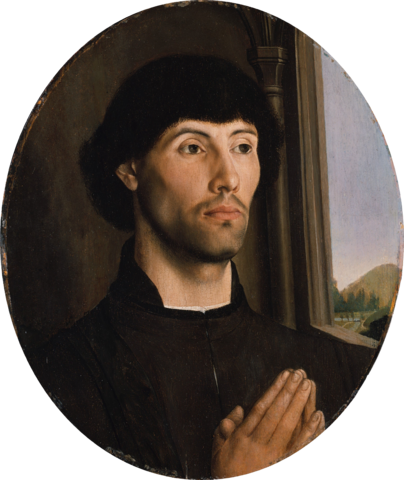
Born: c. 1430 – 1440, Ghent
Died: 1482 (aged 42 – 52)
Period: Early Dutch Renaissance
The Life of Hugo van der Goes
Hugo van der Goes was a prominent Flemish painter during the Northern Renaissance, known for his significant contribution to the development of painting in the Low Countries. His works are characterized by their emotional depth, intricate detail, and innovative use of color and light, setting new standards for realism and expressiveness in Northern European art.
Van der Goes was born in or near Ghent (now in Belgium) and spent much of his career there. By the mid-1460s, he had become a master in the Ghent painters’ guild, and his reputation as a leading artist of his time was well established. In 1474, he entered the Rood Klooster (Red Cloister), a monastery near Brussels, although he continued to paint.
One of his most celebrated works, the “Portinari Altarpiece” (c. 1475), was commissioned by Tommaso Portinari, a representative of the Medici family in Bruges, for the church of Sant’Egidio in Florence. This large triptych, depicting the Adoration of the Shepherds, is renowned for its detailed portrayal of the figures and landscape, and its vivid use of color. The altarpiece made a profound impact on Italian artists when it arrived in Florence, influencing the development of Renaissance art in Italy.
Despite his success, historical records suggest that van der Goes suffered from psychological distress in his later years, which may have affected his ability to work. He died in 1482, leaving behind a relatively small but highly influential body of work. His paintings, which include altarpieces, portraits, and religious narratives, are noted for their deep humanity, capturing the emotional and spiritual experiences of their subjects with great sensitivity and insight.
Hugo van der Goes’ legacy in the history of art is marked by his mastery of technique and his ability to convey complex emotions, making him one of the most important and innovative artists of the Northern Renaissance. His work not only had a significant impact on his contemporaries and the next generation of artists in the Low Countries but also contributed to the broader development of European art.
Hugo van der Goes’ Notable Works
Hugo van der Goes was a pivotal figure in the Northern Renaissance, known for his intricate detail, emotional depth, and innovative approach to color and composition. Here are ten of his most famous and influential works, showcasing his contribution to the art world:
- The Portinari Altarpiece (c. 1475) – This monumental triptych, commissioned for the church of Sant’Egidio in Florence, is van der Goes’ most celebrated work. It depicts the Adoration of the Shepherds with a realism and attention to detail that had a profound impact on the development of Italian Renaissance art.
- The Adoration of the Kings (Monforte Altarpiece, c. 1470) – This painting, now housed in the Gemäldegalerie, Berlin, is notable for its portrayal of the Magi’s visit to the newborn Christ. The work is admired for its detailed landscape and expressive figures.
- The Fall of Man (c. 1470) – This work, part of a larger piece that includes the depiction of the Lamentation of Christ, showcases van der Goes’ skill in rendering biblical narratives with emotional intensity and rich symbolism.
- The Death of the Virgin (c. 1480) – This poignant scene captures the moment of the Virgin Mary’s death, surrounded by the apostles. The painting is celebrated for its detailed characterization and the mood of solemnity and mourning.
- The Trinity Altarpiece (c. 1471-1473) – Also known as the “Edinburgh Altarpiece,” this work was commissioned for a church in Edinburgh and is an important example of van der Goes’ religious compositions, featuring the Holy Trinity and various saints.
- St. Hippolyte Triptych (c. 1468) – This triptych shows Saint Hippolyte flanked by other saints and scenes from his life. The work is known for its vivid portrayal of the saints and its detailed landscape backgrounds.
- The Calvary Triptych (c. 1468) – This early work by van der Goes depicts the Crucifixion, showcasing his ability to convey the drama and emotion of religious scenes.
- Virgin and Child with Saints (c. 1470) – This devotional piece, showcasing the Virgin Mary with the Christ Child and surrounded by saints, highlights van der Goes’ skill in creating intimate religious compositions.
- The Lamentation of Christ (c. 1480) – Often paired with “The Fall of Man,” this work depicts the sorrowful scene following Christ’s crucifixion, emphasizing van der Goes’ ability to capture deep human emotion.
- Portrait of a Man (c. 1475) – Although primarily known for his religious works, van der Goes also produced a small number of portraits, including this striking example that demonstrates his skill in capturing the individual character of his sitters.
Hugo van der Goes’ works are celebrated for their profound impact on the Northern Renaissance, blending technical mastery with a deep sense of humanity and spirituality. His paintings continue to be admired for their beauty, complexity, and emotional depth.